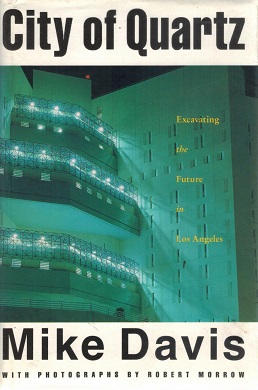City of Quartz facts for kids

First edition
|
|
| Author | Mike Davis |
|---|---|
| Country | United States |
| Language | English |
| Series | Haymarket |
| Subject | History |
| Genre | Non-fiction |
| Publisher | Verso Books |
|
Publication date
|
October 17, 1990 |
| Media type | |
| Pages | 472 pp. |
| ISBN | 978-0860913030 |
City of Quartz: Excavating the Future in Los Angeles is an important book from 1990 by Mike Davis. It looks closely at how the city of Los Angeles has been shaped by powerful groups and ideas throughout its history. The book starts with Davis visiting the old ruins of a special community called Llano. This community was set up in 1914 in the Antelope Valley, north of Los Angeles. It was a place where people tried to create a different kind of society. Even though the community moved in 1918, Davis sees its "ghost" as a reminder of other possible futures for LA.
Contents
Exploring Los Angeles's Past
Mike Davis explores many different ideas about Los Angeles. He shows how various groups have tried to define the city.
Early Ideas of Los Angeles
In the early 1900s, people selling land in Los Angeles promoted it as a "sunshine" paradise. They wanted to attract new residents. But other writers, called "muckraking journalists," dug up the truth. They exposed problems and corruption in the city.
Darker Stories and New Thinkers
Later, in the 1930s, "noir" writers told darker stories about Los Angeles. These stories often featured crime and mystery. At the same time, many people fleeing from difficult situations in Europe came to LA. The book also talks about the "sorcerers," which is what Davis calls the smart scientists at the Caltech. They also helped shape the city's future.
Who Held the Power in LA?
The book then looks at how different groups in Los Angeles gained and used their power.
Powerful Families and Groups
One powerful group was the old Protestant families from downtown LA. The Chandler family, who owned the Los Angeles Times newspaper, was very influential. They helped decide what happened in the city. Another strong group was the newer wealthy families from the Jewish Westside area.
Community Influence and Law Enforcement
Homeowner groups, made up of people who owned houses, also had a surprising amount of power. They could influence decisions about their neighborhoods. The Los Angeles Police Department was another very strong force in the city.
Religious Communities
Davis also writes about the Catholic Church in Los Angeles. Its leaders were often from Irish backgrounds. However, most of the church members were Latino. This sometimes led to disagreements and different ideas within the church.
The End of a Dream
The book finishes in a place Davis calls the "junkyard of dreams." This is the town of Fontana, east of Los Angeles. It used to be a busy steel town. But when the factories closed, the town faced many problems and fell into decay. This shows how economic changes can affect communities.
Updates to the Book
A second edition of City of Quartz came out in 2006. This new version included a special introduction. It talked about all the changes that had happened in Los Angeles since Mike Davis first wrote the book in the late 1980s.

